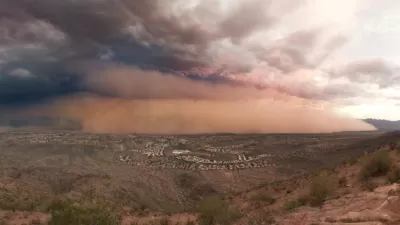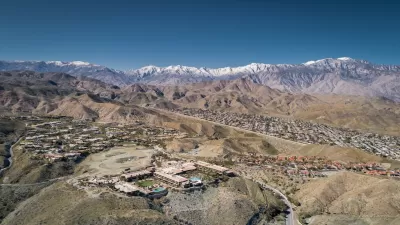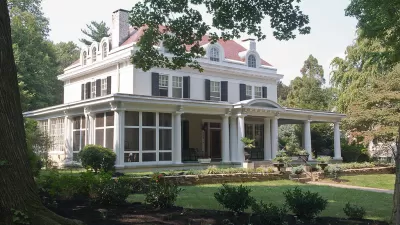Atlantic Cities details the new urbanist vision of a master planned community called Eastmark in Mesa, Arizona. The development’s mix of uses, form-based code, and walkability create “an uncommon sales pitch for car-dependent Arizona.”

Developer DMB Associates is in the midst of the first phase of the “first major new master-planned development to break ground in the Phoenix metro area in almost 10 years,” writes Sommer Mathis. The development site totals 3,200 acres adjacent to the small but growing Phoenix-Mesa Gateway Airport, and a master plan that looks, at least on paper, like a new kind of of suburban community—one that prioritizes the public realm and a jobs-housing balance made possible by two major employers.
The specifics of Eastmark’s suburban differentiation include:
- “Two major employers, Grand Canyon University, Arizona's largest for-profit Christian university, and GT Advanced Technologies, a supplier of sapphire-glass iPhone components for Apple, announced in the second half of last year that they would be moving in to Eastmark.”
- “...multifamily buildings, retail centers, civic areas, and a 100-acre Great Park will all converge down the middle of the development to complete the package…”
- “[Mesa’s] first application of a form-based zoning code.”
The article is part of the America 360 series.
FULL STORY: The Future of the Suburbs Is Unfolding in Arizona's East Valley

Planetizen Federal Action Tracker
A weekly monitor of how Trump’s orders and actions are impacting planners and planning in America.

Restaurant Patios Were a Pandemic Win — Why Were They so Hard to Keep?
Social distancing requirements and changes in travel patterns prompted cities to pilot new uses for street and sidewalk space. Then it got complicated.

Map: Where Senate Republicans Want to Sell Your Public Lands
For public land advocates, the Senate Republicans’ proposal to sell millions of acres of public land in the West is “the biggest fight of their careers.”

Maui's Vacation Rental Debate Turns Ugly
Verbal attacks, misinformation campaigns and fistfights plague a high-stakes debate to convert thousands of vacation rentals into long-term housing.

San Francisco Suspends Traffic Calming Amidst Record Deaths
Citing “a challenging fiscal landscape,” the city will cease the program on the heels of 42 traffic deaths, including 24 pedestrians.

California Homeless Arrests, Citations Spike After Ruling
An investigation reveals that anti-homeless actions increased up to 500% after Grants Pass v. Johnson — even in cities claiming no policy change.
Urban Design for Planners 1: Software Tools
This six-course series explores essential urban design concepts using open source software and equips planners with the tools they need to participate fully in the urban design process.
Planning for Universal Design
Learn the tools for implementing Universal Design in planning regulations.
Heyer Gruel & Associates PA
JM Goldson LLC
Custer County Colorado
City of Camden Redevelopment Agency
City of Astoria
Transportation Research & Education Center (TREC) at Portland State University
Camden Redevelopment Agency
City of Claremont
Municipality of Princeton (NJ)





























